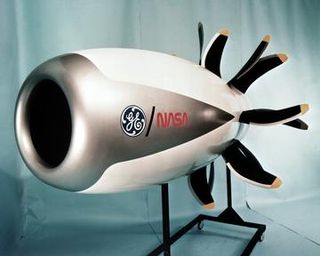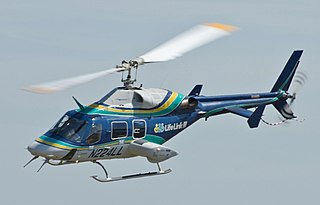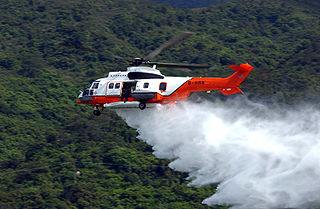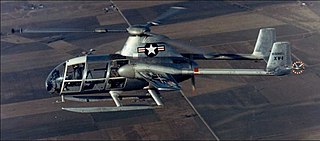
A vertical take-off and landing (VTOL) aircraft is one that can hover, take off, and land vertically. This classification can include a variety of types of aircraft including fixed-wing aircraft as well as helicopters and other aircraft with powered rotors, such as cyclogyros/cyclocopters and tiltrotors. Some VTOL aircraft can operate in other modes as well, such as CTOL, STOL, and/or STOVL. Others, such as some helicopters, can only operate by VTOL, due to the aircraft lacking landing gear that can handle horizontal motion. VTOL is a subset of V/STOL. Some lighter-than-air aircraft also qualify as VTOL aircraft, as they can hover, takeoff, and land with vertical approach/departure profiles.

The Boeing CH-47 Chinook is an American twin-engined, tandem rotor, heavy-lift helicopter developed by American rotorcraft company Vertol and manufactured by Boeing Vertol. The CH-47 is among the heaviest lifting Western helicopters. Its name, Chinook, is from the Native American Chinook people of modern-day Washington state.

A tiltrotor is an aircraft which generates lift and propulsion by way of one or more powered rotors mounted on rotating engine pods or nacelles usually at the ends of a fixed wing or an engine mounted in the fuselage with drive shafts transferring power to rotor assemblies mounted on the wingtips. It combines the vertical lift capability of a helicopter with the speed and range of a conventional fixed-wing aircraft. For vertical flight, the rotors are angled so the plane of rotation is horizontal, lifting the way a helicopter rotor does. As the aircraft gains speed, the rotors are progressively tilted forward, with the plane of rotation eventually becoming vertical. In this mode the wing provides the lift, and the rotor provides thrust as a propeller. Since the rotors can be configured to be more efficient for propulsion and it avoids a helicopter's issues of retreating blade stall, the tiltrotor can achieve higher speeds than helicopters.
The CarterCopter is an experimental compound autogyro developed by Carter Aviation Technologies in the United States to demonstrate slowed rotor technology. On 17 June 2005, the CarterCopter became the first rotorcraft to achieve mu-1 (μ=1), an equal ratio of airspeed to rotor tip speed, but crashed on the next flight and has been inoperable since. It is being replaced by the Carter Personal Air Vehicle.

A propfan, also called an open rotor engine, unducted fan, or ultra high-bypass turbofan, is a type of aircraft engine related in concept to both the turboprop and turbofan, but distinct from both. The design is intended to offer the speed and performance of a turbofan, with the fuel economy of a turboprop. A propfan is typically designed with a large number of short, highly twisted blades, similar to a turbofan's bypass compressor. For this reason, the propfan has been variously described as an "unducted fan" or an "ultra-high-bypass (UHB) turbofan."

The Bell 222 is an American twin-engine light helicopter built by Bell Helicopter. The Bell 230 is an improved development with different engines and other minor changes.

NOTAR is a helicopter system which avoids the use of a tail rotor. It was developed by McDonnell Douglas Helicopter Systems. The system uses a fan inside the tail boom to build a high volume of low-pressure air, which exits through two slots and creates a boundary layer flow of air along the tailboom utilizing the Coandă effect. The boundary layer changes the direction of airflow around the tailboom, creating thrust opposite the motion imparted to the fuselage by the torque effect of the main rotor. Directional yaw control is gained through a vented, rotating drum at the end of the tailboom, called the direct jet thruster. Advocates of NOTAR believe the system offers quieter and safer operation.

A helicopter main rotor or rotor system is the combination of several rotary wings and a control system that generates the aerodynamic lift force that supports the weight of the helicopter, and the thrust that counteracts aerodynamic drag in forward flight. Each main rotor is mounted on a vertical mast over the top of the helicopter, as opposed to a helicopter tail rotor, which connects through a combination of drive shaft(s) and gearboxes along the tail boom. The blade pitch is typically controlled by a swashplate connected to the helicopter flight controls. Helicopters are one example of rotary-wing aircraft (rotorcraft). The name is derived from the Greek words helix, helik-, meaning spiral; and pteron meaning wing.

A gyrodyne is a type of VTOL aircraft with a helicopter rotor-like system that is driven by its engine for takeoff and landing and also includes one or more conventional propellers to provide forward thrust during cruising flight. Lift during forward flight is provided by a combination of the rotor, like an autogyro, and conventional wings. Due to a number of issues, there is some confusion over the term "gyrodyne", and the terms compound helicopter and compound gyroplane are frequently used to describe the same design. The gyrodyne is one of a number of similar concepts which attempt to provide helicopter-like low-speed performance and conventional fixed-wing high-speeds, including tiltrotors and tiltwings.

A rotorcraft or rotary-wing aircraft is a heavier-than-air flying machine that uses lift generated by wings, called rotary wings or rotor blades, that revolve around a mast. Several rotor blades mounted on a single mast are referred to as a rotor. The International Civil Aviation Organization (ICAO) defines a rotorcraft as "supported in flight by the reactions of the air on one or more rotors". Rotorcraft generally include those aircraft where one or more rotors are required to provide lift throughout the entire flight, such as helicopters, autogyros, and gyrodynes. Compound rotorcraft may also include additional thrust engines or propellers and static lifting surfaces.

A helicopter is a type of rotorcraft in which lift and thrust are supplied by rotors. This allows the helicopter to take off and land vertically, to hover, and to fly forward, backward, and laterally. These attributes allow helicopters to be used in congested or isolated areas where fixed-wing aircraft and many forms of VTOL aircraft cannot perform.

The McDonnell XV-1 is an experimental compound gyroplane developed for a joint research program between the United States Air Force and the United States Army to explore technologies to develop an aircraft that could take off and land like a helicopter but fly at faster airspeeds, similar to a conventional airplane. The XV-1 would reach a speed of 200 mph, faster than any previous rotorcraft, but the program was terminated due to the tip-jet noise and complexity of the technology which gave only a modest gain in performance.

Slowed rotor is a concept in designing and flying certain rotorcraft. Reducing the rotational speed of the rotor reduces the drag, enabling the aircraft to go faster and/or fly more economically.
The Bauer BAD-12 Gyrotrainer is a Czech autogyro, designed and produced by Bauer Avion of Prague. The aircraft is supplied as a complete ready-to-fly-aircraft.
The Redback Buzzard is an Australian helicopter that was designed and produced by Redback Aviation of Hoppers Crossing, Victoria. The aircraft was intended to be supplied as a kit for amateur construction, but only one prototype was ever completed and development ended.
North American Rotorwerks LLC is an American aircraft manufacturer based in Tukwila, Washington, founded by John Vanvoorhees. The company specializes in the design and manufacture of autogyros in the form of kits for amateur construction.
















